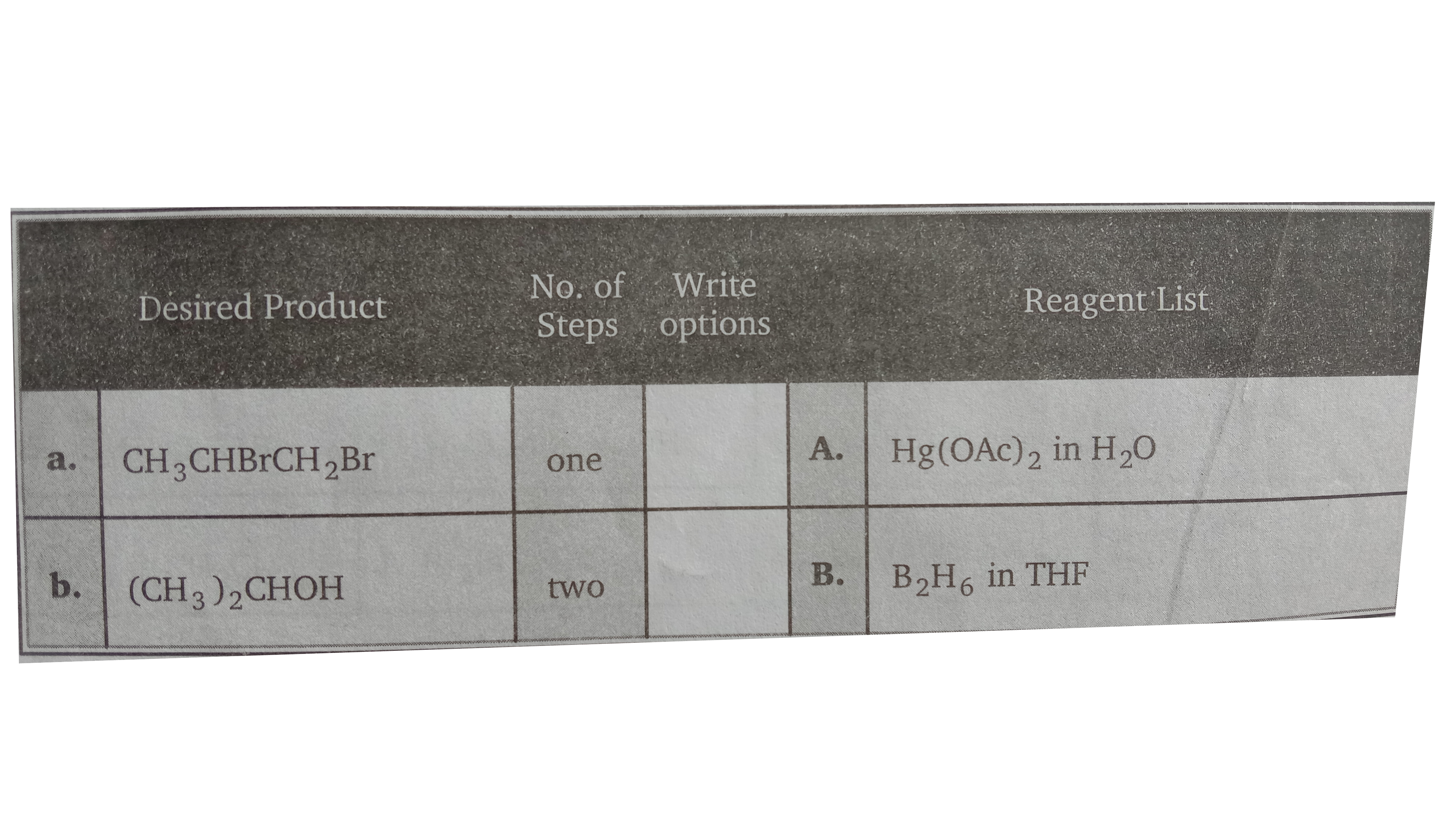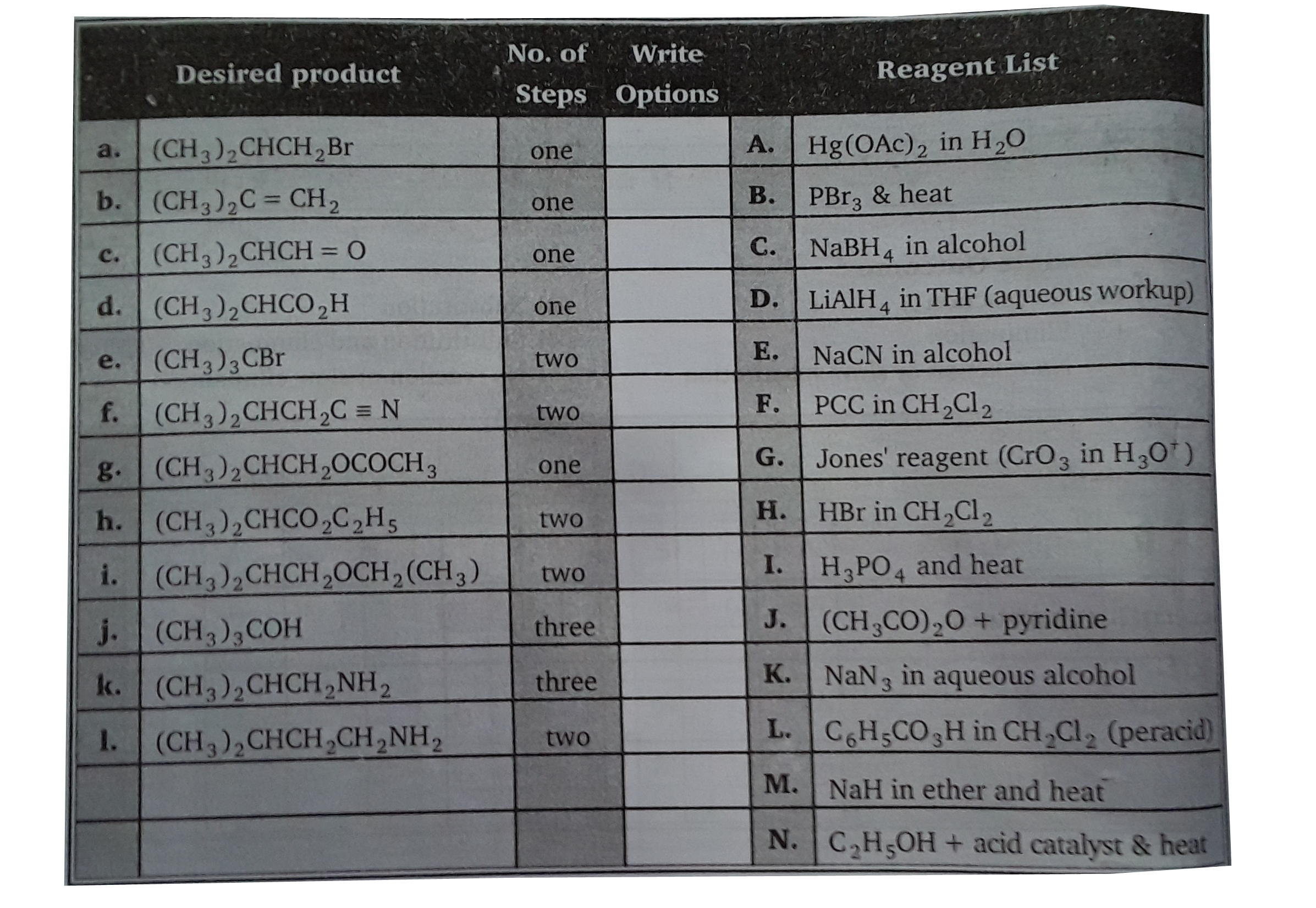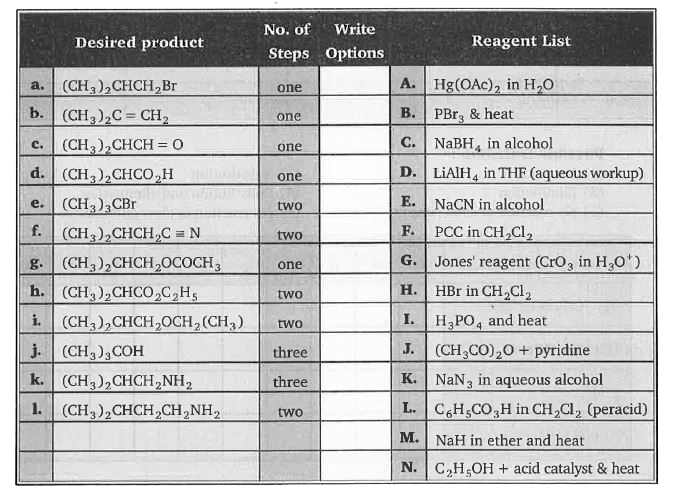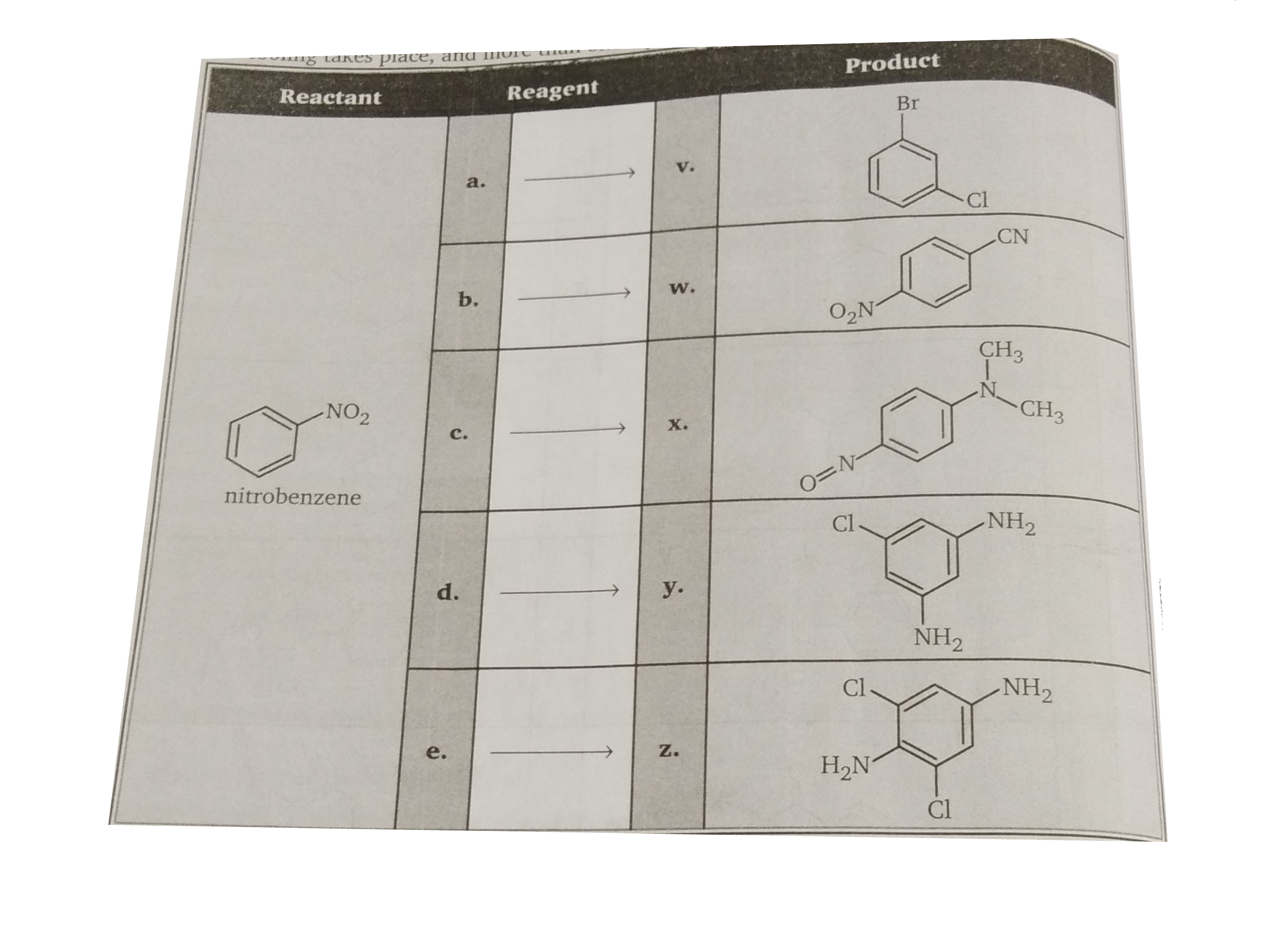Propene (CH3−CH=CH2) can be transformed to compounds (a to j) listed in the left-hand column.
Write letter designating the reagent, you believe desired transformation. In the case of multi-step sequence write the reagent in the order they are to be used.


The correct Answer is:a-D; b-A,C; c-B,E; d-A,C,F; e-B,E,F; f-F; g-G; h-I,K; i-B,E,I; j-D,I.
(a) Halogenation
(b)Oxymercuration-De-mercuration reaction (OMDM reaction)
(c) Hydroboration-oxidation reaction (HBO reaction)
(d) CH3CH=CH2OMDM−−−−→CH3−O∣∣C−CH3HOBr−−−−−−−−−−→oxidising agentCH3−CH2−CHO
(h) Halohydrin formation
(g) Oxidation reaction
(i) CH3−CH=CH2HBO−−→CH3−CH2−CH2−OHSOCl2−−−−−−−−−−−→Darzene processCH3−CH2−CH2−Cl+SO2+HCl
(j) Halogenation and elimination
Topper's Solved these Questions
- HYDROCARBONS (ALKENES)BOOK - MS CHOUHANCHAPTER - HYDROCARBONS (ALKENES)EXERCISE - LEVEL - 2
1 Videos
- HYDROCARBONS (ALKENES)BOOK - MS CHOUHANCHAPTER - HYDROCARBONS (ALKENES)EXERCISE - Level 1 (Q.211 To Q.232)
1 Videos
- HYDROCARBONS (ALKANES)BOOK - MS CHOUHANCHAPTER - HYDROCARBONS (ALKANES)EXERCISE - Level 1 (Q.31 To Q.50)
1 Videos
- HYDROCARBONS (ALKYNES)BOOK - MS CHOUHANCHAPTER - HYDROCARBONS (ALKYNES)EXERCISE - Level 1 (Q.1 To Q.30)
2 Videos
Similar Questions
Isobuty alcohol (2 -mehyl 1 -1-propanol), (CH3)2CHCH2OH, can be transformed to each of the compounds (a through 1) listed in the left-hand column. In each case the number of steps the needed to accomplish the change is noted, and an answer box is noted, and answer box is provided for your reagent selections. Fourteen reagents (designated A through N) are listen in the right -hand column. corresponding to the desired compound.
Write letters desiganating the raagent or reagents you believe will achieve the desired transformation in the box to the right of the product formula. In the case of a multi-step sequence write the reagents in the order they are to be used. In some cases you may wish to use a previously prepared compound as a reactant. If so, write the number (a to 1) corresponding to the desired compound.
View SolutionIsobutyl alcohol (2-methyl-1-propanol) (CH3)2CHCH2OH, can be transformed to each of the compounds (a through 1) listed in the left-hand column. In each case the number of steps needed to accomplish the change is noted, and an answer box is provided for your reagent Write letters designating the reagent or reagents you believe will achieve the desired transformation in the box to the right of the product formula. In the case of a multi-step sequence write the reagents in the order they are to be used. In some cases you maywish to use a previously prepared compound as a reactant. If so, write the number (a to 1) corresponding to the desired compound.

View Solution
Knowledge Check
Propene, CH3−CH=CH2, can be converted to 1-propanol by oxidation. Which set of reagents among the following is ideal to effect the conversion?
AAlkaline KMnO4BB2H6 and alkaline H2O2CO3/Zn dustDOsO4/NaHSO3Propene, CH3−CH=CH2, can be converted to 1-propanol by oxidation. Which set of reagents among the following is ideal to effect the conversion?
AAlkaline KMnO4BB2H6 and alkaline H2O2CO3/Zn dustDOsO4/CH4,Cl2Propene, CH3–CH=CH2 can be converted into 1– propanol by oxidation. Which set of reagents among the following is ideal to effect the conversion -
AAlkaline KMnO4BB2H6 and alk. H2O2CO3 / zinc dustDOsO4/CHCl3
Propene, CH3−CH=CH2, can be converted to 1-propanol by oxidation. Which set of reagents among the following is ideal to
effect the conversion?
View SolutionNitrobenzene is a versatile compound that may be converted inot a wide variety of subsituted benzenes. Five such synthesis are shown below. In each reaction box above an arrow write letters designating the reagents and conditions, selected from the list at the bottom of the page, that would effect the transformation. The reagents must be written in the answer box in the correct order of their use. You may assume appropriate heating or cooling takes place, and more than one equivalent of the reagent may be used if needed.

ReagentsReagentsAH2,NicatalystFCl2 & FeCl3BKBr & Cu2Br2GNaOH10% solutionCKCN & Cu2(CN)2H(CH3CO)2O, pyridineDHNO20∘CIHNO3/H2SO4ECH3I & pyridine
View SolutionPropene CH3CH=CH2 can be converted into 1-propanol by oxidation. Indicate which sets of reagents amongst the following is ideal to effect the above conversion?
View SolutionPropene CH3CH=CH2 can be converted into 1-propanol by oxidation. Indicate which sets of reagents amongst the following is ideal to effect the above converseion?
View SolutionPropene, CH3CH=CH2 can be converted into propan-1-ol by oxidation. Indicate which set of reagents amongst the following is ideal for the above conversion?
View Solution
